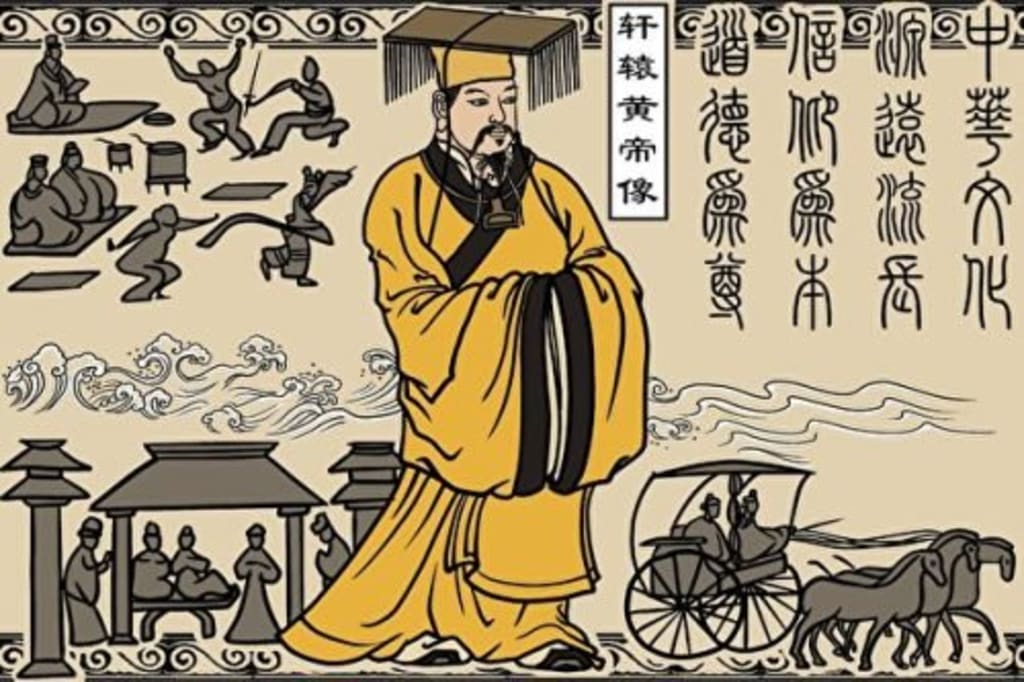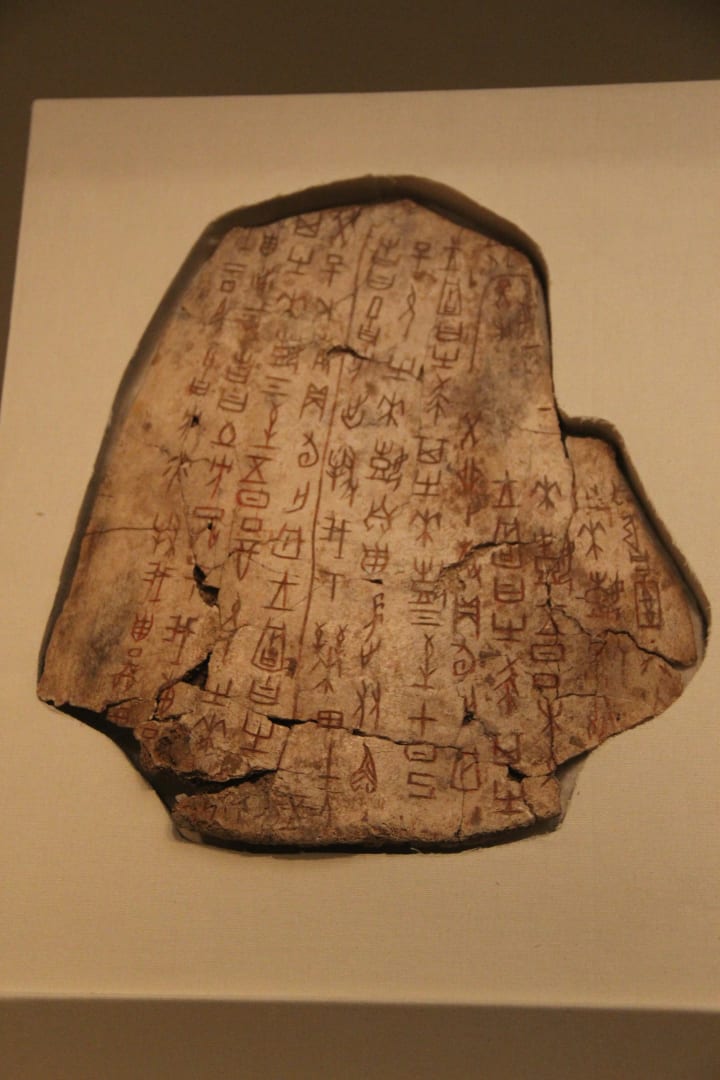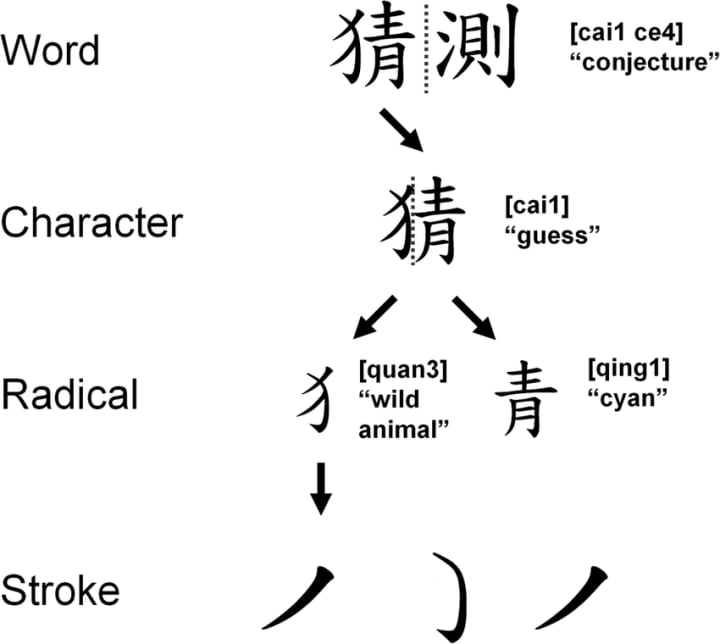Unveiling the Mystique of Chinese Characters
A Journey Through Time and Language

The Mythical Origins
According to legend, the origins of Chinese characters can be traced back to the 27th century BCE, when the Yellow Emperor of China tasked his historian, Cangjie, with developing a system of writing. Sitting beside a riverbank, Cangjie drew inspiration from the natural imagery around him. From this, he created the first Chinese characters. The legend says that the night he completed his work, the sky rained millet while ghosts wept, fearing their actions would now be recorded and judged. Although this story is steeped in myth, it highlights the profound significance attributed to the birth of Chinese writing.
The Shang Dynasty's Legacy

While the tale of Cangjie may be apocryphal, the earliest physical evidence of Chinese characters dates back to the Shang Dynasty (circa 1250 to 1050 BCE). Archaeologists have uncovered oracle bones, ox bones, and turtle shells inscribed with these ancient characters. These artifacts reveal that Shang kings communicated with their ancestors on matters ranging from agricultural practices to the origins of ailments. These characters were primarily pictograms, symbols representing objects, and ideograms, symbols depicting abstract concepts. Even today, some foundational Chinese characters remain true to their pictographic roots, such as 人 (rén) for person and 木 (mù) for tree.
The Structure of Chinese Characters

The evolution of Chinese characters from pictograms to the complex logograms used today involves a fascinating structural transformation. Characters are constructed from radicals and sound components. Radicals provide clues about the meaning, while sound components suggest pronunciation. For instance, the character 休 (xiū), meaning to rest, combines the radical for person (人) with the radical for tree (木), implying a person resting under a tree. This system allows for the creation of thousands of characters, each with a unique combination of meaning and sound.
Simplification and Modern Usage

In the 1950s and 60s, the Chinese government introduced simplified characters to improve literacy rates and streamline writing. These characters, used primarily in mainland China, feature fewer strokes and simplified structures compared to their traditional counterparts. However, traditional characters remain in use in Hong Kong, Taiwan, and among overseas Chinese communities. This dual system reflects the dynamic evolution of the Chinese script and its adaptability to different cultural and political contexts.
Radicals and Their Roles
Radicals, of which there are 214, are integral to understanding and learning Chinese characters. Some radicals can stand alone as individual characters, while others are used exclusively as components. For example, the radical 日 (rì) means sun and appears in characters related to the sun, such as 晓 (xiǎo) meaning dawn. Conversely, the radical 艹 (cǎo), symbolizing grass, never stands alone but is found in characters like 花 (huā) meaning flower. The placement of radicals within characters—whether to the left, right, above, below, or surrounding the main component—provides additional context for interpretation.
The Power of Sound Components
Sound components play a crucial role in the Chinese writing system, aiding in pronunciation and sometimes offering semantic hints. Consider the characters 峰 (fēng) meaning summit and 蜂 (fēng) meaning bee. Both share the sound component 丰 (fēng), but their radicals 山 (shān) for mountain and 虫 (chóng) for insect differentiate their meanings. This intricate interplay between sound and meaning components enriches the language and provides learners with a systematic approach to understanding pronunciation and meaning.
The Cultural and Linguistic Influence
The influence of Chinese characters extends beyond China’s borders. Japanese kanji characters, for instance, originated from Chinese logograms and form a significant part of the Japanese writing system. Approximately 60% of Japanese dictionary entries are kanji, illustrating the deep-rooted connection between the two languages. Similarly, Korean hanja characters also derive from Chinese. This cross-cultural linguistic exchange highlights the widespread impact and adaptability of Chinese characters.
Learning Chinese Characters: A Journey
Mastering Chinese characters requires dedication, patience, and an appreciation for their historical and cultural significance. For beginners, understanding the basic strokes and radicals is crucial. Characters are built from eight fundamental strokes, including horizontal, vertical, and diagonal lines. These strokes combine in various ways to form the thousands of characters in use today. For example, the character 永 (yǒng) meaning eternal, showcases all eight basic strokes, making it a fundamental learning tool.
Simplification and Modern Usage
In the 1950s and 60s, the Chinese government introduced simplified characters to improve literacy rates and streamline writing. These characters, used primarily in mainland China, feature fewer strokes and simplified structures compared to their traditional counterparts. However, traditional characters remain in use in Hong Kong, Taiwan, and among overseas Chinese communities. This dual system reflects the dynamic evolution of the Chinese script and its adaptability to different cultural and political contexts.
The Timeless Appeal of Chinese Characters
With a history spanning over 3,000 years, Chinese characters are more than just a writing system—they are a testament to the enduring nature of cultural expression. From their mythical origins to their modern applications, these characters offer a unique window into Chinese civilization. They have adapted to technological advancements, influenced neighboring languages, and continue to captivate language learners worldwide. As we delve into the world of Chinese characters, we not only learn a language but also connect with a rich tapestry of history, culture, and artistic expression.
About the Creator
Mojalefa Mokoena
Discover the world through the eyes of Mojalefa Mokoena, a passionate storyteller from the heart of South Africa. Mojalefa's narratives blend cultural richness with contemporary insights, offering a unique perspective on global themes
Enjoyed the story? Support the Creator.
Subscribe for free to receive all their stories in your feed. You could also pledge your support or give them a one-off tip, letting them know you appreciate their work.






Comments (2)
This is A very awesome article
Good work. I always thought of the written forms in Chinese or the other Asian writing forms were like art.